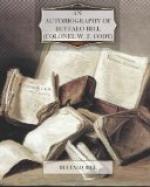I also got up a race for my pony, Powder Face, against a fast pony belonging to Major Lute North, of the Pawnee Scouts. I selected a small boy living at the Post for a jockey, Major North rode his own pony. The Pawnees, as usual, wanted to bet on their pony, but as I had not yet ascertained the running qualities of Powder Face I did not care to risk much on him. Had I known him as well as I did afterward I would have backed him with every cent I had. He proved to be one of the swiftest ponies I ever saw, and had evidently been kept as a racer.
The dash between the ponies was to be four hundred yards. When I led Powder Face over the course he seemed to understand what he was there for. North was on his pony; my boy was up. I had all I could do to hold the fiery little fellow back. He was so lively on his feet that I feared his young rider might not be able to stick on his back.
At last the order to start was given by the judges. I brought Powder Face up to the score, and the word “Go!” was given. So swiftly did he jump away that he left his rider sitting on the ground. Nevertheless he went through and won the race without a rider. It was an easy victory, and after that I could get no more races.
General Carr having obtained a leave of absence, Colonel Royal was given command of an expedition that was ordered to go out after the Indians. In a few days we set out for the Republican, where, we had learned, there were plenty of Indians.
At Frenchman’s Fork we discovered a village, but did not surprise it, for the Indians had seen us approaching and were in retreat as we reached their camping-place.
We chased them down-stream and through the sandhills, but they made better time than we did, and the pursuit was abandoned.
While we were in the sandhills, scouting the Niobrara country, the Pawnee Indians brought into camp some very large bones, one of which the surgeon of the expedition pronounced to be the thigh bone of a human being. The Indians said the bones were those of a race of people who long ago had lived in that country. They said these people were three times the size of a man of the present day, that they were so swift and strong that they could run by the side of a buffalo, and, taking the animal in one arm, could tear off a leg and eat it as they ran.
These giants, said the Indians, denied the existence of a Great Spirit. When they heard the thunder or saw the lightning, they laughed and declared that they were greater than either. This so displeased the Great Spirit that he caused a deluge. The water rose higher and higher till it drove these proud giants from the low grounds to the hills and thence to the mountains. At last even the mountaintops were submerged and the mammoth men were drowned.
After the flood subsided, the Great Spirit came to the conclusion that he had made men too large and powerful. He therefore corrected his mistake by creating a race of the size and strength of the men of the present day. This is the reason, the Indians told us, that the man of modern times is small and not like the giants of old. The story has been handed down among the Pawnees for generations, but what is its origin no man can say.




